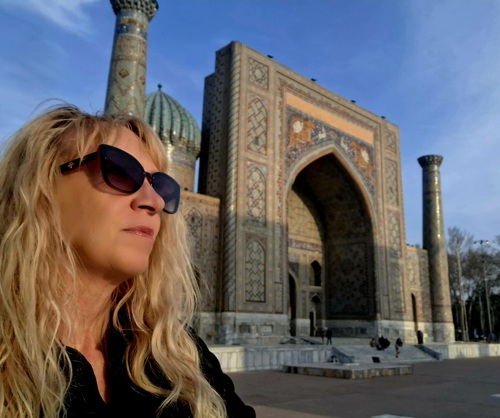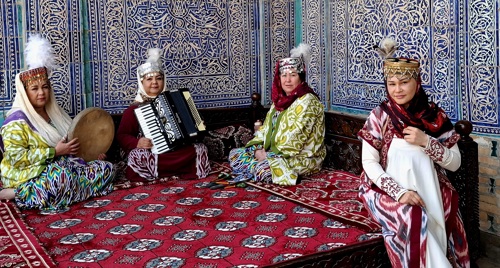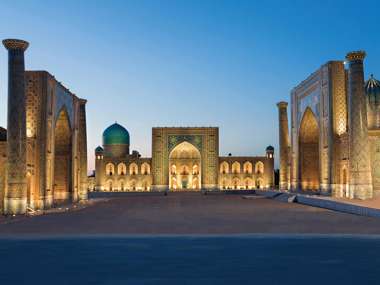A personal account from Uzbekistan
Uzbekistan has sat on atop my bucket list for some time now. I was delighted to finally get the opportunity to travel to this jewel of Central Asia in March. It was simply splendid! I visited the three ancient cities of Samarkand, Bukhara and Khiva, and was overwhelmed with the incredible hospitality I encountered, every step of my journey.

Why Visit?
Traveling to Uzbekistan offers a unique blend of historical grandeur, cultural richness, and natural beauty. Here are just a few compelling reasons to explore this captivating destination:
- Historical Treasures
- Cultural Heritage
- Architectural Marvels
- Craftsmanship and Arts
- Authentic Experiences
- Modern Amenities
- Safety and Hospitality

Uzbekistan is a jubilant celebration of history and tradition, a land that proudly sets itself apart from the rest of Central Asia. Its fertile landscapes cradle a legacy of permanence, where ancient majestic fortresses stand as triumphant guardians to a glorious past.
The footsteps of Alexander the Great once echoed through its valleys, and by 700 A.D., the armies of Islam had woven the sacred message of Muhammad into the cultural and spiritual fabric of Uzbekistan. But it was under the luminous reign of Tamerlane in the 14th century that Uzbekistan ascended to its Golden Age—a resplendent era immortalized in the breathtaking Islamic architecture of Samarkand
My Favourite Haunts
Samarkand
In the mystical tapestries of the Silk Road, Samarkand emerges as a shimmering jewel, a city drenched in the twilight hues of history and culture. Over 2,500 years, this ancient metropolis proudly stood as a crossroads of civilizations, a throne of empires, and a sanctuary of art and science. Today, its breathtaking architecture and timeless tales beckon wanderers to its storied streets with a harmonious blend of ancient lore and vibrant modernity, echoing the everlasting legacy of the Silk Road in every mosaic and minaret.

At the heart of Samarkand lies resplendent Registan Square, here three grand madrasahs rise as sentinel guardians, their intricate mosaics and cerulean domes glistening in the sunlight. As twilight descends, the square is bathed in a golden glow, whispering the fables of merchants and artisans who called this magical place home. Samarkand was the cradle of Tamberlane, who anointed the city the crown jewel of his empire. His imprint immortalized in the Gur-e-Amir, the splendidly decorated mausoleum shimmering with a kaleidoscope of turquoise, azure, and lapis lazuli, each tile an ode of devotion and artistry, and at Bibi-Khanym Mosque, an awe-inspiring marvel of the Timurid dynasty.
Beyond its historic grandeur, Samarkand pulses with the heartbeat of contemporary Uzbek culture. Lively Siab Bazaar has the tantalizing aroma of fresh baking and vibrant displays of dried fruits, nuts, and spices, offering a sensory odyssey and a window into the soul of local life.
Bukhara
Bukhara, a jewel of the ancient Silk Road is Central Asia’s holiest city, rising from desert sands, it is a city carved by time and devotion. Its minarets stretch skyward, their edges softened by centuries of light and shadow. The Kalyan Minaret, untouched by the wrath of Genghis Khan, watches in silence—a sentinel of survival, etched with the stories of a bygone age.
The air carries the whispers of the Silk Road, where merchants once bartered silk and spices, dreams and ambitions. In the dim glow of caravanserais, voices from Persia, China, and distant lands mingled, stitching together a mosaic of human enterprise that bridged continents.
It is beneath the blue and turquoise mosaics, that the Ark stands—a fortress that offered sanctuary and bore witness to the thrones of rulers. In its shadow, life pulses, unyieldingly. Threads of gold shimmer in artisans' hands, their craft a devotion, each stitch and carving an offering to the soul of the city.

Bukhara’s cultural soul isn’t just preserved—it breathes, through its architecture, its artisan crafts, that made the great legendary Silk Road city, and the spirit of its people, eternally tied to the past yet alive in the present. In the sacred serenity of its mosques and madrasas, whispers of devotion still drift. In workshops hidden from plain view, the past is alive. Blades are forged by knife makers whose fire reflects the spirit of resilience. Miniaturists paint stories of kings and Sufi saints, their brushes breathing life into forgotten faces. Wood is carved into intricate patterns, seeking elegance and permanence.
Bukhara is more than walls and domes; it is a living manuscript. Each street, an untold tale; each breeze, a carrier of memories. It is a city where footsteps tread not on stones, but on layers of time, where every glance catches a glint of history.

The city holds its heritage like an heirloom: As you walk its old town and alleyways, as you absorb its stories, the city will embrace you; another thread in its endless tapestry.
Khiva
Khiva is more than just a destination, it is a city of timeless charm, here history and romance blend seamlessly and time seems to linger in the golden glow of its ancient walls. For centuries caravans laden with silks and spices paused here on their journey along the Silk Road, the oasis, a shimmering jewel amid the arid expanse. The city grew into a beacon, not only of trade but of culture, scholarship, and spirituality. Within its mud-brick walls lies Ichan-Kala, its towering walls embrace the city like a protective guardian; the inner fortress—a haven of artistry and devotion. The Kalt Minor Minaret rises as an unfinished ode to ambition, while Djuma Mosque’s carved columns echo prayers from across centuries.

Khiva invites you not just to wander its streets, but to fall under its spell, the past feels eternal, and every corner holds the promise of a story waiting to be told. In the bustling bazaar, vibrant textiles flutter in the desert breeze, and rhythmic melodies of traditional Khorezmian music fill the air. Intricately tiled domes gleam under the sun, reflecting centuries of artistry and devotion and the geometric patterns of mosques and madrasas sing a triumphant hymn of Uzbek craftsmanship and heritage, embodying the city’s spirited soul.

When is best to go?
Spring arrives early in Uzbekistan, apricot trees blossom in early March, followed by the cherry blossoms. The weather in spring is warm and relatively dry, with temperatures hovering between 14°C (57°F) and 30°C (86°F). From March till early June, you can enjoy comfortable weather and make the most out of the sunny days.
September until November is a great time for autumn harvests. The season is mild and pleasant with daytime temperatures of between 21˚C (70˚F) and 30˚C (86˚F). But the best reason is that you can indulge in a feast of fruits of the harvest with seasonal produce including their famous melons and watermelons.










